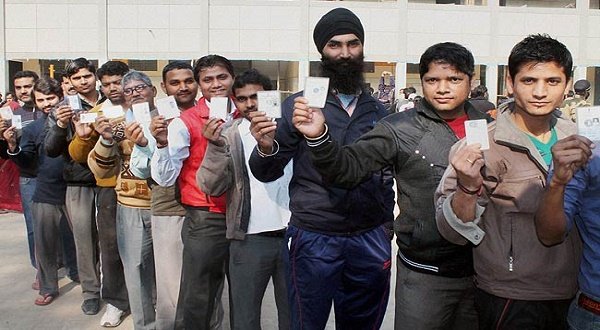
In these elections, BJP committed the kind of mistakes Congress was guilty of in 2014; back then, Modi won against Congress by playing up his underdog tag; how is it that he allowed Arvind Kejriwal to turn the tables, snatch the underdog status, and force Modi to act like Congress in terms of mobilizing huge resources of the State against what was considered a dead party after 2014 general election results?
AMARESH MISRA
NEW DELHI – Politics does not run on emotions or the stars. A crude, raw logic, the logic of social-mass dynamics, governs its ups and downs.
Who would have thought 6 months back that invincible Mr. Modi and his brand of right wing populism will suffer a set-back, that too in Delhi? Who would have expected Kejriwal, the underdog, to make a spectacular comeback?
Exit polls show AAP winning more than 40 seats. BJP is supposed to win just 22; Congress might not even open its account.
In these elections, BJP committed the kind of mistakes Congress was guilty of in 2014; back then, Modi won against Congress by playing up his underdog tag; how is it that he allowed Arvind Kejriwal to turn the tables, snatch the underdog status, and force Modi to act like Congress in terms of mobilizing huge resources of the State against what was considered a dead party after 2014 general election results?
The fact remains that Delhi elections mark a major setback for Modi, BJP and the RSS—and their policies. Here, the issue was not one of `corruption’, `good governance’ or `minority appeasement’.
Two agendas that the BJP pursued over the last 6 months—a clear pro-corporate (crony capitalist), pro-rich politics, and the open ratcheting of the majoritarian-communal pitch—were on line this time around.
Modi probably thought that his larger than life image, and clever realpolitik of forming an anti-status quo, anti-incumbent alliance of social-caste forces, that demolished Shiv Sena in Maharashtra, the powerful Jat lobby in Haryana, and the entrenched JMM in Jharkhand, will repeat itself automatically in Delhi.
But Delhi is different; it is India’s fastest growing State; it combines a huge migrant labor population, impoverished minorities, flourishing service-manufacturing sector, multiple Colleges and Universities nursing a restive, aspirant student force, the feisty neo-rich and arrogant, anti-poor brats with creaking infrastructure, angry demands, road rage, crime and urbanized class contradictions. No one social-caste force is dominant; social tensions revolve largely around status and class.
At a much more basic level, Modi should have seen the writing on the wall during Jammu & Kashmir elections; he came very close to winning Kashmir and making history. But something—probably RSS—held him back; Modi’s original line of a right-wing Hindu Nationalist leader establishing a direct connect with Muslims of Kashmir was not allowed to come into operation.
The loss of connect, which was evident on a small scale in Kashmir, assumed a huge shape in Delhi. Modi allowed the usual money machine of ruling parties to take over his early style, used to devastating effect in 2014, of political bonding with the masses.
Delhi elections were the first where Modi appeared out of touch with his trademark mass politics; has constant traveling, playing a bigger role at the International stage, sapped his grassroots vigil and grasp? Have moneybags made him complacent?
Choice of Kiran Bedi as a CM candidate was seen by people as a sign of weakness on part of Amit Shah, the BJP President. So far in provincial elections, dominating Modi had not announced a CM candidate; he went into battle to ask for votes in his name. In Delhi, BJP announced a pre-poll candidate for the first time; what is more, Kiran Bedi is an ex-top cop with a non-political reputation. She angered several BJP workers by her standoffish behavior.
Modi suffered also, because he was not allowed to, or chose not, to control the extreme right fringe of the `ghar waapsi’ type. Liberal Hindus, who stood by him during general elections, got alienated.
It is significant that political forces of the old variety were unable to defeat him. Regional forces and caste-provincial satraps, lost out to him. Again, it was not caste—but a class—force—the slum dwelling poor, the workers, the underclass, lower middle class, and the middle class that has risen due to hard work—that appear likely to defeat BJP on 10th February.
Whatever the outcome, Indian politics stands fundamentally altered; emergence of a new force, with a solid pro-poor, populist orientation, looms large on the horizon. Victory of populist, radical Left parties in Greece, and their rise in Spain and Germany, is assuming the shape of a worldwide trend.
Till now, Congress was India’s populist-party par excellence; AAP is a quasi-Left organization; its populism is very India-centric, and comes close to a new, `hi-tec/NGO’ avatar of the `phakkad’ marka centrist-socialist politics of yore, revolving around basic peoples issues like `Bijli-Paani’.
Since AAP has no national presence, Congress can re-invent itself as a radical, Left-populist, Nehruvian party with a strong emphasis on peasantry, workers, tribals, oppressed nationalities, land reforms and economic nationalism.
The organized Left too can take advantage of the situation—but again, it will have to re-orient its priorities, come out of its doctrinaire ghettoism, and hit the street on popular issues.
Regional centrist-populist forces, threatened with extinction by Modi’s rise, can breathe easy—but only for a while. Bihar elections are their test case; if they can’t measure up to people’s expectations, they will be sidelined.
Since May 2014, Narendra Modi had dominated the political scene to a point any other alternative was not visible for miles on end. But, Delhi election has opened up the political space; India is going to witness many old/new combinations in a new avatar; if Congress or the Left are not able re-invent their politics, fresh forces will emerge to fill in the vacuum. The Indian political pendulum has started swinging again—and there is no telling where it’s going to stop.
Amaresh Misra is Editor-in-Chief, Medhaj News
http://medhajnews.com/article.php?id=NjcyNg==


